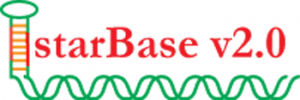Status:
Platform:
Methods:
Species:
MicroRNAs (miRNAs) represent an important class of small non-coding RNAs (sRNAs) that regulate gene expression by targeting messenger RNAs. However, assigning miRNAs to their regulatory target genes remains technically challenging. Recently, high-throughput CLIP-Seq and degradome sequencing (Degradome-Seq) methods have been applied to identify the sites of Argonaute interaction and miRNA cleavage sites, respectively. In this study, we introduce a novel database, starBase (sRNA target Base), which we have developed to facilitate the comprehensive exploration of miRNA-target interaction maps from CLIP-Seq and Degradome-Seq data. The current version includes high-throughput sequencing data generated from 21 CLIP-Seq and 10 Degradome-Seq experiments from six organisms. By analyzing millions of mapped CLIP-Seq and Degradome-Seq reads, we identified ~1 million Ago-binding clusters and ~2 million cleaved target clusters in animals and plants, respectively. Analyses of these clusters, and of target sites predicted by 6 miRNA target prediction programs, resulted in our identification of approximately 400,000 and approximately 66,000 miRNA-target regulatory relationships from CLIP-Seq and Degradome-Seq data, respectively. Furthermore, two web servers were provided to discover novel miRNA target sites from CLIP-Seq and Degradome-Seq data. Our web implementation supports diverse query types and exploration of common targets, gene ontologies and pathways. The starBase is available at http://starbase.sysu.edu.cn/.[1]
MicroRNAs (miRNAs) are endogenous non-coding RNAs (ncRNAs) of approximately 22 nt that regulate the expression of a large fraction of genes by targeting messenger RNAs (mRNAs). However, determining the biologically significant targets of miRNAs is an ongoing challenge. In this chapter, we describe how to identify miRNA-target interactions and miRNA regulatory networks from high-throughput deep sequencing, CLIP-Seq (HITS-CLIP, PAR-CLIP) and degradome sequencing data using starBase platforms. In starBase, several web-based and stand-alone computational tools were developed to discover Argonaute (Ago) binding and cleavage sites, miRNA-target interactions, perform enrichment analysis of miRNA target genes in Gene Ontology (GO) categories and biological pathways, and identify combinatorial effects between Ago and other RNA-binding proteins (RBPs). Investigating target pathways of miRNAs in human CLIP-Seq data, we found that many cancer-associated miRNAs modulate cancer pathways. Performing an enrichment analysis of genes targeted by highly expressed miRNAs in the mouse brain showed that many miRNAs are involved in cancer-associated MAPK signaling and glioma pathways, as well as neuron-associated neurotrophin signaling and axon guidance pathways. Moreover, thousands of combinatorial binding sites between Ago and RBPs were identified from CLIP-Seq data suggesting RBPs and miRNAs coordinately regulate mRNA transcripts. As a means of comprehensively integrating CLIP-Seq and Degradome-Seq data, the starBase platform is expected to identify clinically relevant miRNA-target regulatory relationships, and reveal multi-dimensional post-transcriptional regulatory networks involving miRNAs and RBPs. starBase is available at http://starbase.sysu.edu.cn/ .[2]
Although microRNAs (miRNAs), other non-coding RNAs (ncRNAs) (e.g. lncRNAs, pseudogenes and circRNAs) and competing endogenous RNAs (ceRNAs) have been implicated in cell-fate determination and in various human diseases, surprisingly little is known about the regulatory interaction networks among the multiple classes of RNAs. In this study, we developed starBase v2.0 (http://starbase.sysu.edu.cn/) to systematically identify the RNA-RNA and protein-RNA interaction networks from 108 CLIP-Seq (PAR-CLIP, HITS-CLIP, iCLIP, CLASH) data sets generated by 37 independent studies. By analyzing millions of RNA-binding protein binding sites, we identified ~9000 miRNA-circRNA, 16 000 miRNA-pseudogene and 285,000 protein-RNA regulatory relationships. Moreover, starBase v2.0 has been updated to provide the most comprehensive CLIP-Seq experimentally supported miRNA-mRNA and miRNA-lncRNA interaction networks to date. We identified ~10,000 ceRNA pairs from CLIP-supported miRNA target sites. By combining 13 functional genomic annotations, we developed miRFunction and ceRNAFunction web servers to predict the function of miRNAs and other ncRNAs from the miRNA-mediated regulatory networks. Finally, we developed interactive web implementations to provide visualization, analysis and downloading of the aforementioned large-scale data sets. This study will greatly expand our understanding of ncRNA functions and their coordinated regulatory networks.[3]
References
- starBase: a database for exploring microRNA-mRNA interaction maps from Argonaute CLIP-Seq and Degradome-Seq data.,
, Nucleic Acids Res, 2011 Jan, Volume 39, Issue Database issue, p.D202-9, (2011)
- Discovery of microRNA regulatory networks by integrating multidimensional high-throughput data.,
, Adv Exp Med Biol, 2013, Volume 774, p.251-66, (2013)
- starBase v2.0: decoding miRNA-ceRNA, miRNA-ncRNA and protein-RNA interaction networks from large-scale CLIP-Seq data.,
, Nucleic Acids Res, 2014 Jan, Volume 42, Issue Database issue, p.D92-7, (2014)







